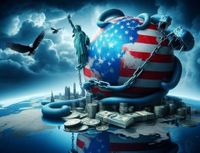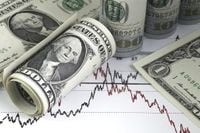The global economy faces a rising tide of uncertainty as new tariffs imposed by former President Donald Trump are projected to significantly increase the chances of a recession. According to a report from J.P. Morgan, the likelihood of a global recession has surged to 60%, up from 40%, due to the economic impacts of these tariffs.
In a recent analysis, J.P. Morgan strategists led by chief economist Bruce Kasman highlighted that Trump’s administration introduced a basic 10% tariff on all imported goods into the United States, alongside increased tariffs on imports from numerous other countries. This sweeping policy shift is being recognized as the largest tax increase for U.S. households and businesses since 1968.
Kasman warned that if these tariffs remain in place, they could lead not only to a recession in the United States but also have ripple effects across the global economy in 2025. "The risk of recession in the global economy this year has increased from 40% to 60%," he stated in a note to clients, emphasizing that the repercussions could be far-reaching.
Several factors contribute to this grim outlook. The tariffs are expected to trigger retaliatory measures from trading partners, which could further destabilize international trade relations. Additionally, a decline in business sentiment in the U.S. is anticipated, alongside disruptions in supply chains that have already been strained by various global issues.
Wall Street analysts from firms such as Barclays and Deutsche Bank echoed these concerns, suggesting that the U.S. economy is at an elevated risk of entering a recession if Trump's new tariffs persist. The economic climate has shifted, becoming less favorable for business than previously anticipated, according to J.P. Morgan.
Despite these challenges, Kasman noted that the impact of the tariffs could be "moderately smoothed" by the potential for further interest rate cuts in the United States. J.P. Morgan has confirmed its forecast of two Federal Reserve rate cuts of 25 basis points each in June and September of this year. Investors are currently anticipating a total of four rate cuts throughout 2025, as reported by LSEG data.
The current economic landscape is marked by tension and uncertainty. As businesses grapple with the implications of the tariffs, many are left questioning their future strategies. The sentiment on Wall Street is cautious, with numerous firms preparing for a potentially turbulent economic period.
On April 3, 2025, several Wall Street companies issued stark warnings about the impending recession. The announcements followed Trump’s declaration of major tariffs on goods imported from various countries around the world. Analysts are particularly concerned about how these tariffs will affect consumer spending, business investments, and overall economic growth.
Kasman elaborated on the potential fallout, stating, "The effect of this tax increase will likely be amplified due to retaliatory measures, worsening sentiment among business circles in the U.S., and supply chain disruptions." The interconnected nature of global trade means that these tariffs could lead to a domino effect, impacting economies far beyond U.S. borders.
As businesses and consumers alike brace for the implications of these tariffs, the focus now shifts to policymakers and their responses. Will the Federal Reserve act swiftly enough to mitigate the damage? Can the U.S. government negotiate with its trading partners to find a more favorable resolution? These questions loom large as economic analysts and businesses watch closely for any signs of change.
In conclusion, the economic forecast is becoming increasingly concerning as the ramifications of Trump’s tariffs unfold. With a 60% chance of a global recession looming, the stakes are high for both the U.S. and the international community. The coming months will be crucial in determining the trajectory of the global economy as it navigates these turbulent waters.





